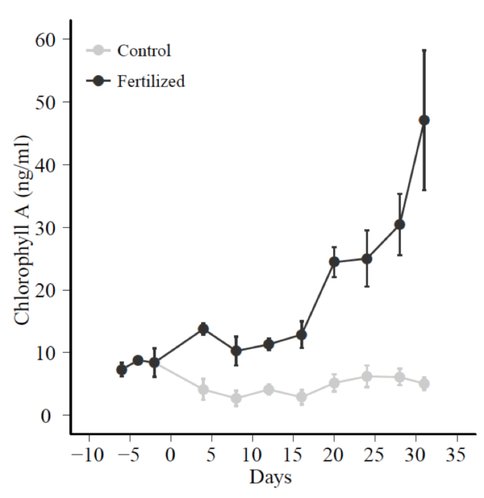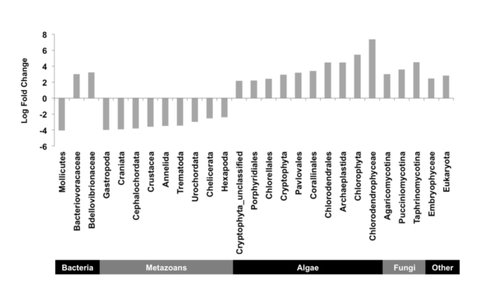2014 Annual Science Report
 Arizona State University
Reporting | SEP 2013 – DEC 2014
Arizona State University
Reporting | SEP 2013 – DEC 2014
Stoichiometry of Life - Task 2b - Field Studies in Cuatro Cienegas
Project Summary
We performed two studies to evaluate ecological impacts of nitrogen and/or phosphorus fertilization in a P-deficient and hyperdiverse shallow pond in the valley of Cuatro Cienegas, Mexico.
Project Progress
Phosphorus limitation and element use in microbial communities: During the past reporting period, a manuscript reporting biogeochemical responses in our 2011 mesocosm experiment in the small evaporative pond Lagunita was accepted (Lee et al. 2015). Data derived from deep pyrosequencing of 16S and 18S rDNA extracted from water and sediment samples from the mesocosms is now undergoing final analyses in preparation for a new manuscript. Exemplary 18S data are shown in Figure 1. Overall, we saw a strong response of the water column aquatic microbial community to all fertilizer treatments, but responses of sediment microbes were muted. 16S data showed that taxa that are not well characterized and have few cultivated representatives, such as Sphingobacteriales, Comamonadaceae, and Saprospiraceae, decreased in relative abundance in the fertilized treatments (data not shown). On the other hand, well-characterized genera such as Rubrimonas, Erythrobacter and Roseococcus increased in the fertilized mesocosms. A preview of these data was presented at the ASLO Ocean Science meeting in February 2014.
In 2012, we conducted a whole-pond fertilization experiment of Lagunita Pond that included internal unenriched controls. Biogeochemical and ecological data have been analyzed (see Figure 2), revealing a large effect of fertilization on biomass as was seen in the 2011 mesocosm experiment. With a longer fertilization period for this experiment, we were able to observe an initial phase of slow immobilization of nutrients into the seston in the first 16 days. This was followed by rapid uptake in the later 16 days of the experiment. We have completed shotgun metagenomic sequencing of ~18 samples collected as part of the whole-pond fertilization experiment and its replicated internal control mesocosms. These will be one of the first replicated metagenomic studies ever completed and will allow us unprecedented insight into changes microbial community composition as well as shifts in associated metabolic pathways. Bioinformatic analyses of these metagenomes is now nearing completion (see Figure 3 for a first glimpse).
Other studies:
Calcification, nutrient cycling, and microbial community structure in Río Mesquites stromatolites: Graduate student Jessica Corman completed the laboratory and data analyses of her study of nutrient limitation to microbial communities in Río Mesquites. She is currently preparing this work for publication.
Diverse aquatic environments of Cuatro Ciénegas: Graduate students Jessica Corman and Jorge Ramos have completed the biogeochmical analyses of water samples collected from over 30 distinct water bodies in the valley. They are preparing this work for publication.
Environmental microbiology: UNAM researcher Valeria Souza and her collaborators and students continued to advance studies in association with the NASA NAI project to describe the microbial community structure and genetic composition of various ecosystems at Cuatro Ciénegas, including soil and sediment microbes as well as the microbes composing various stromatolite structures in the basin (see various papers and manuscripts listed). In the Churince System, microbial community structure is related to local physicochemical characteristics and nutrient availability, suggesting the environment determines microbial community composition. We have also collaborated with this team to complete a study of soil ecoenzymes that yielded notable data on C, N, and P utilization by CC microbes in the most oligotrophic soils yet characterized using these emerging methodologies (Tapia-Torres et al. in review).
Publications
-
Aguirre-von-Wobeser, E., Eguiarte, L. E., Souza, V., & Soberón-Chávez, G. (2015). Theoretical analysis of the cost of antagonistic activity for aquatic bacteria in oligotrophic environments. Frontiers in Microbiology, 6. doi:10.3389/fmicb.2015.00490
-
Aguirre-von-Wobeser, E., Soberón-Chávez, G., Eguiarte, L. E., Ponce-Soto, G. Y., Vázquez-Rosas-Landa, M., & Souza, V. (2013). Two-role model of an interaction network of free-living γ-proteobacteria from an oligotrophic environment. Environmental Microbiology, 16(5), 1366–1377. doi:10.1111/1462-2920.12305
-
Pajares, S., Souza, V., & Eguiarte, L. E. (2015). Multivariate and Phylogenetic Analyses Assessing the Response of Bacterial Mat Communities from an Ancient Oligotrophic Aquatic Ecosystem to Different Scenarios of Long-Term Environmental Disturbance. PLoS ONE, 10(3), e0119741. doi:10.1371/journal.pone.0119741
-
Perroni, Y., García-Oliva, F., & Souza, V. (2014). Plant species identity and soil P forms in an oligotrophic grassland–desert scrub system. Journal of Arid Environments, 108, 29–37. doi:10.1016/j.jaridenv.2014.04.009
-
Perroni, Y., García-Oliva, F., Tapia-Torres, Y., & Souza, V. (2014). Relationship between soil P fractions and microbial biomass in an oligotrophic grassland-desert scrub system. Ecological Research, 29(3), 463–472. doi:10.1007/s11284-014-1138-1
-
Ponce-Soto, G. Y., Aguirre-von-Wobeser, E., Eguiarte, L. E., Elser, J. J., Lee, Z-P., & Souza, V. (2015). Enrichment experiment changes microbial interactions in an ultra-oligotrophic environment. Frontiers in Microbiology, 6. doi:10.3389/fmicb.2015.00246
-
Tapia-Torres, Y., Elser, J. J., Souza, V., & García-Oliva, F. (2015). Ecoenzymatic stoichiometry at the extremes: How microbes cope in an ultra-oligotrophic desert soil. Soil Biology and Biochemistry, 87, 34–42. doi:10.1016/j.soilbio.2015.04.007
-
PROJECT INVESTIGATORS:
-
PROJECT MEMBERS:
James Elser
Project Investigator
Ariel Anbar
Co-Investigator
Christopher Dupont
Co-Investigator
Janet Siefert
Co-Investigator
Valeria Souza
Co-Investigator
Jessica Corman
Collaborator
Zarraz Lee
Collaborator
Amisha Poret-Peterson
Collaborator
Jorge Ramos
Collaborator
-
RELATED OBJECTIVES:
Objective 5.1
Environment-dependent, molecular evolution in microorganisms
Objective 5.2
Co-evolution of microbial communities
Objective 5.3
Biochemical adaptation to extreme environments
Objective 6.1
Effects of environmental changes on microbial ecosystems
Objective 6.2
Adaptation and evolution of life beyond Earth


